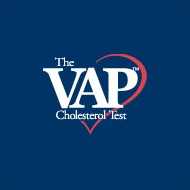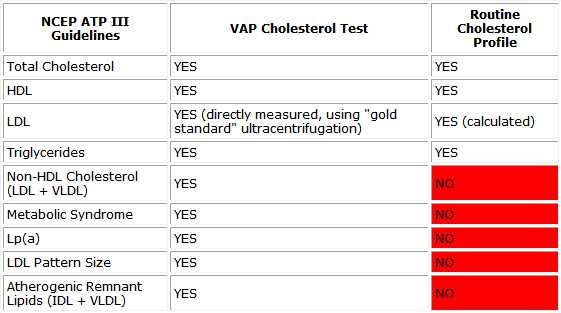
Accuscan VAP Cholesterol Test
The National Cholesterol Education Program recommends that people begin having regular cholesterol tests at age 20. The VAP Test is the only cholesterol profile that tests for all the present and emerging risk factors identified in the NCEP cholesterol guidelines. Compliance with the new NCEP ATP III (Adult Treatment Program) Guidelines vs. ATP II has been shown to increase the overall number of patients identified at risk by 40%, and more than 200% for those less than 45 years of age. In addition to measuring your cholesterol, the VAP test measures other heart disease risk factors such as your homocysteine and C-Reactive Protein levels.
Homocysteine
Homocysteine is a substance produced as the body digests protein. Although the body requires normal levels of homocysteine to build and maintain tissues, excess levels can be associated with heart disease and stroke and may contribute to arterial wall injury. Arteries damaged by this process are more likely to narrow or close completely due to infiltration of cholesterol during atherosclerosis. Therefore, homocycteine is an excellent marker for the status of a patient's vascular fitness.
HsCRP
High sensitivity C-Reactive Protein (hsCRP) has been recognized for its ability to predict future coronary events in apparently healthy individuals. Recent data have shown that the predictive value of hsCRP is significantly higher than that associated with traditional or novel biochemical risk markers. HsCRP is an excellent marker for assessing the risk of a heart attack because acute inflammation increases the potential for plaque rupture.
How do I take a VAP test?
Call and make an appointment today 801-456-7226. No Fasting is required prior to the blood draw for your VAP test.
At this very moment one in four Americans are dying from heart disease. The technology Accuscan offers holds enormous potential for radically improving that statistic. Take control of your life and future; visit Accuscan, a whole new way of enriching your health.
Make an appointment TODAY by calling 801-456-7226, it may be the most significant ten minutes of your life.
-



801.456.7226



VAP vs. Routine Cholesterol Test
Only the VAP Cholesterol Test achieves the new NCEPO ATP III Guideline objective to improve patient risk assessment and promote more aggressive therapy. The routine cholesterol test information can only account for approximately 45% of cholesterol abnormalities while the VAP patient profile identifies up to 90%.
THE VAP CHOLESTEROL TEST EXPLAINED
The best way to explain the VAP test is line-by-line using your VAP results as a guide.
Direct Measured Lipid Profile
- Total Cholesterol (NCEP guidelines <200mg/dL) is defined as the sum of HDL+LDL+VLDL. The TC is only a number and cannot be used in any way to diagnosis a person’s risk for heart disease, MI, or stroke.
- HDL Cholesterol (NCEP guidelines >40mg/dL) is the sum of all the sub fractions that make up the HDL total, which are HDL2 and HDL3.
- LDL Cholesterol (NCEP guidelines <130mg/dL) is defined as the sum of LDL-R + Lp(a) + IDL. LDL Cholesterol is a sum of three different subfractions.
- Triglycerides (NCEP guidelines <150mg/dL) are based on the concentration of the triglyceride rich molecules IDL and VLDL.
The rest of the test describes the risk to the patient because it dissects the above values so that the physician can treat the cholesterol sub fraction that is of risk potential.
Additional lipid subclass information such as direct LDL, LDL pattern density, Lipoprotein (a) and HDL2 will increase detection rates to 90% of all patients who will have heart disease, up from 40% with the traditional lipid panel.
For Informed Clinical Judgment Use
This section of the test is where the decisions for treatment should arise.
HDL Cholesterol Panel
- HDL2 turns out to be the protective sub-fraction of HDL, so that total HDL measurements (if mostly HDL3) may under-estimate the real atherogenic risk to patients. Low HDL2 is a risk for CAD even in patients with normal cholesterol. It is also an independent risk factor for diabetics with peripheral vascular disease. Campos H, Arterioscler Thromb Vas Biol. 1995 Aug 15(8) 213-9
- HDL3 though important, it does not play as large a role in protection against CAD as HDL2. Therefore, emphasis should remain on the HDL2 subfraction when evaluating a patients HDL cholesterol status. Larnarche B, Arterioscler Thromb Vas Biol. 1997 Jun; 17(6): 1098-105
This is critical because it is not total HDL that protects but rather HDL2.
LDL Cholesterol Panel
- LDL-R is the patient’s real LDL value. This value is derived from the total LDL cholesterol value minus the Lp(a) and the IDL cholesterol values. This directly measured LDL-R is what is responsible for the largest of majority of atherosclerosis cases and this is what most physicians treat. This fraction is typically, though not always, attributed to diet.
- Lp(a) is also known as the “widow maker” or “heart attack” cholesterol. When elevated Lp(a) is associated with the atherogenic lipoprotein profile (low HDL2, elevated dense LDL, IDL, dense VLDL and VLDL) the increase risk is 25. If two or more non-lipid risk factors are also present (hypertension, diabetes, cigarette smoking, or high total Homocysteine) the increased risk is 122. Lp(a) is entirely genetic or metabolic in origin and therefore, lifestyle or diet does not modify this subfraction. The only way to reduce this subfraction is drug intervention. Sandkamp M, Clin Chem. 1990 Jan;36(1):20-3 and Williams RR, Arterioscler Thromb Vasc Biol. 1997 Nov;17(11):2783-92
- IDL, also known as intermediate density lipoprotein, is an independent risk factor for CAD. IDL is under very strong genetic or metabolic control and usually requires drug interaction to regulate if values are abnormal or patient is at risk. Zambon A, et al. Curr Opin Lipidol. 1998 Aug;9(4):329-36
- LDL Pattern (desirable result is pattern A) refers to the density of the LDL cholesterol. It is important to realize that this describes the density of the LDL-R and has nothing to do with the value of the LDL. There is a 50/50 chance of pattern being a hereditary problem or lifestyle/diet problem. In either case this is a serious condition.
One point that must be understood before one goes any further is that all LDL-R cholesterol over 100mg/dL is considered a risk.
- Now with this in mind there are forms of LDL that are “safer” than others. LDL pattern A is the safest and biologically preferred form. The large buoyant LDL is remove by the receptor dependant pathway, hence HDL receptor dependant pathway. It requires a max time (found on the lower right hand portion of the VAP test) of 118.0 sec or higher. LDL pattern A/B is a mixture of pattern A and pattern B and requires a max time of 117.99 sec-115.01 sec. LDL pattern B (also called dense LDL) is any time below 115.00 sec max time. Pattern B LDL carries the highest threat because it is much more susceptible to oxidation (one of the main causes for atherosclerosis) and remains in the blood stream 40% longer than LDL pattern. Also, it being smaller and more dense, it can infiltrate the endothelial lining of the arties much easier. Once in the lining the particle deposits its cholesterol burden initiating the process of atherosclerosis by cell mediated removal of cholesterol. So, a person with an LDL-R 125mg/dL is considered mildly elevated but in conjunction with LDL pattern B the risk are elevated tremendously. Treatment for LDL pattern B and elevated LDL cholesterol are different so both must be known. Superko HR. Am J Cardiol. 1998 Nov 5;82(9A):34Q-46Q
- Again, with either pattern A or B, all LDL-R cholesterol over 100mg/dL is considered a risk.
Triglyceride-rich Lipids Panel
- VLDL, VLDL3 as well IDL are all triglyceride-rich lipids. It has been shown that elevated levels of VLDL3 are an independent risk factor for CAD. But how much is too much? There is some controversy over this issue but some consensus has been observed. If the VLDL3 is greater than 10mg/dL then treatment consideration should be observed. Rubenfire M., Prog Cardiovasc Dis. 1998 Sep-Oct; 41(2):95-116
Homocysteine
- Homocysteine is a substance produced as the body digests protein. While our bodies require normal levels of homocysteine to build and maintain tissues, excess levels can be associated with heart disease and stroke. High levels of homocysteine may contribute to arterial wall injury. Arteries damaged by this process are more likely to narrow or close completely due to infiltration of cholesterol during atherosclerosis.
- Therefore, homocysteine is an excellent marker for the status of a patient’s vascular fitness. Elevated levels of homocysteine in conjunction with cholesterol abnormalities raise the risk for patients to develop CAD and other vascular complications.
hsCRP
- C-reactive protein (CRP) has been recognized for its ability to predict future coronary events in apparently healthy individuals. Recent data have shown that the predictive value of high sensitivity CRP (hsCRP) is significantly higher than that associated with traditional or novel biochemical risk markers.
- Therefore, elevated hsCRP is an excellent marker for accessing the potential risk for an MI because acute inflammation increases the potential for plaque rupture.
-
UTAH'S PREMIER 3D MEDICAL CT SCAN & ULTRASOUND CENTER